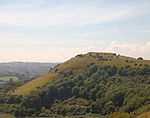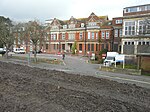2007 Kent earthquake
2000s in Kent2007 earthquakes2007 in EnglandApril 2007 events in the United KingdomDisasters in Kent ... and 4 more
Earthquakes in the United KingdomEngvarB from March 2018FolkestoneFolkestone and Hythe District

The 2007 Kent earthquake registered 4.3 on the Richter scale and struck south east Kent, South East England on 28 April 2007 at 07:18:12 UTC (08:18:12 local time), at a shallow depth of 5.3 km.The worst affected area was the town of Folkestone, although the towns of Deal, Dover and Ashford were also affected. The tremors could be felt across much of Kent and south east England, including as far as East Sussex, Essex and Suffolk, as well as on the other side of the English Channel at Calais and Brussels.
Excerpt from the Wikipedia article 2007 Kent earthquake (License: CC BY-SA 3.0, Authors, Images).2007 Kent earthquake
Service Tunnel, Folkestone and Hythe District Park Farm
Geographical coordinates (GPS) Address Nearby Places Show on map
Geographical coordinates (GPS)
| Latitude | Longitude |
|---|---|
| N 51.1 ° | E 1.17 ° |
Address
Service Tunnel
Service Tunnel
CT19 4QB Folkestone and Hythe District, Park Farm
England, United Kingdom
Open on Google Maps






